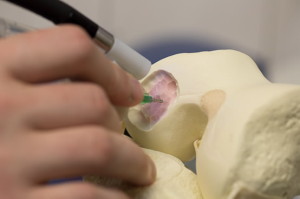We may have received some flak for calling the 3Doodler (and others) FFF pens a “3D printing” pen — with some labelling the device as a “glorified glue gun” — but the BioPen from the University of Wollongong (UOW) in Australia demonstrates just how powerful a 3D printing pen — or a glue gun — can be. The BioPen could potentially give doctors and surgeons the ability to heal bone and cartilage, among other things, relying on the control that only a handheld 3D printing device could deliver.

Not having one of their own, St Vincent’s Hospital Melbourne’s Professor Peter Choong asked the UOW lab to borrow their pen. Though the lab said that they were using it, Prof. Choong said that he just needed it for a second to optimize cell materials for clinical trials and that they could have it right back. Prof. Choong, Director of Orthopaedics at St. Vincent’s, added, “This type of treatment may be suitable for repairing acutely damaged bone and cartilage, for example from sporting or motor vehicle injuries. Professor Wallace’s research team brings together the science of stem cells and polymer chemistry to help surgeons design and personalise solutions for reconstructing bone and joint defects in real time.”
To which ACES acquiesced, as the lab’s Director, Professor Gordon Wallace, reasoned, “The combination of materials science and next-generation fabrication technology is creating opportunities that can only be executed through effective collaborations such as this. What’s more, advances in 3D printing are enabling further hardware innovations in a rapid manner.”
Okay, in actuality, the partnership between the two institutions is bit more than just lending each other pens ACES established a bioprinting lab at St. Vincents in April, 2013, where both institutions have mutually benefitted from technological expertise on the part of ACES and medical expertise on the part of the hospital. Dr. Choong is currently preparing the BioPen prototype for clinical projects to take place at the Aikenhead Centre for Medical Discovery in Melbourne.
For footage of the miraculous device in action, see below:
Source: ACES



